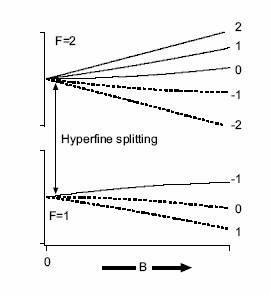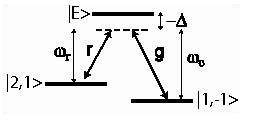Research
- E3: cQED, Optomechanics
- E4: Collective modes
of spinor gases - E5: Optical Kagome Lattice
- E6: cQED, Optical lattice Retired Experiments
- E1: Spinor Rubidium BEC
- E2: Cavity QED
Group Information
- People
- Publications
- Theses
- Presentations
- Research Highlights
- Popular Coverage
- Lab news
- Undergraduate research
Links
- January 2016 MURI Review Meeting
- Useful Links
- Review Papers
- Ultracold Coffee Hour
- Bitbucket: AMO@Berkeley
- Our Old Website
- AMO Seminar (PHYS 290F)
Atom Counting and Photon Fock State Generation Figure 1: Ground state hyperfine structure of 87Rb. For atom counting, the cavity coupling is between the ground |2,+2> and excited |3,+3> states (The excited state lies 780nm above, in the P3/2 manifold). N-atom detection would be on the ground |2,2> and excited |3,3> cycling transition to achieve high signal-to-noise. The resultant recoil heating will be tempered by the presence of the unaffected reservoir of |1,-1> atoms. The generation of atomic Fock states (number-states) can be important for studies of number-squeezed [1] or spin-squeezed [2] atomic systems as well as the production of photonic Fock states [3]. Photonic Fock states are important for quantum cryptography [4] and computation [5]. They can also be used for Heisenberg-limited interferometry as well as provide the starting point for the creation of more complex quantum optical states. The construction of our cavity QED machine allows for atom number counting as well as the conversion of the resultant atomic Fock state to a photonic Fock state. Our system features stable magnetic trapping of an ultracold atomic 87Rb gas within the confines of a high finesse optical cavity. The system will operate in the strong coupling regime of cavity QED. For N atoms coupled to the cavity mode, two cavity resonances appear which are shifted from the empty cavity resonance by (+/-)g*N1/2 (normal mode splitting). In the strong coupling regime, this implies complete discrimination of the cavity resonances observed in transmission and consequent determination of atom number. The spatial size of the atom cloud and its temperature will broaden the cavity resonances resulting in overlap between consecutive atom number resonances. This will ultimately limit the highest atom number that can be reliably counted. For our parameters, efficient atom counting up to N~10 should be possible [6]. From a magnetically trapped cloud in state |1,-1>, a small fraction of atoms will be excited (by a multiphoton RF/microwave transition) into the cavity-coupled state |2,+2>. By coupling in light on the ground |2,+2> to excited |3,+3> cycling transition, the number of atoms in the |2,+2> state can be efficiently detected in transmission. The ground |1,-1> atoms will remain uncoupled and serve as a cold reservoir during optical detection.  Fig. 2: Dark adiabatic passage in a 3 level L-system for the deterministic creation of N photons. States |2,1> and |1,-1> are connected by a 2 photon coupling via excited state |E>. g and wc are the cavity coupling rate and frequency; r and wr are the amplitude and frequency of the external drive. They connect the two ground states by a cavity-mediated Raman transition. N photons can be deterministically generated in the cavity mode [3] by adiabatic dark-state passage of N atoms using a controlled external driving field which connects two ground states by a cavity-induced Raman transition. This has already been demonstrated for the single atom case [7]. The Raman coupled states are chosen to be the ground |1,-1> and |2,+1> states because the transition is then first-order field independent. The appropriate excited state |P> is then the F’=2 excited hyperfine state. The N atom counting will be performed on the cycling ground F=2 à excited F’=3 transition while the adiabatic conversion to N photons will be performed on the ground F=2 à excited F’=2 transition. The cavity will be smoothly tuned over the frequency difference between these two transitions (257 MHz) by gradually scanning a broadband electro-optic modulator which controls the optical signal used to specify the cavity resonance. [1] C. Orzel, A.K. Tuchman, M.L. Fenselau, M. Yasuda, and M.A. Kasevich, Squeezed states in a Bose-Einstein Condensate. Science 291, 2386 (2001). |
| Recent Changes (All) | Edit SideBar | Page last modified on May 15, 2007, at 12:32 AM | Edit Page | Page History |
| Powered by PmWiki | ||

